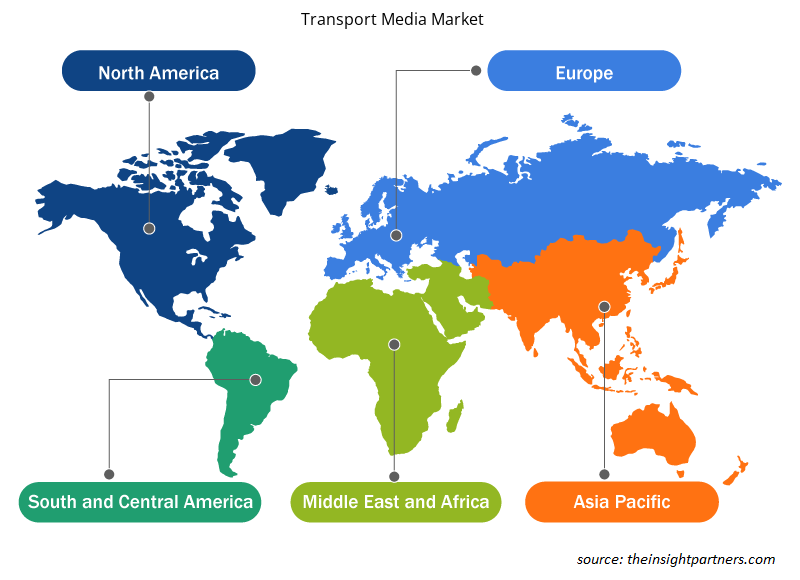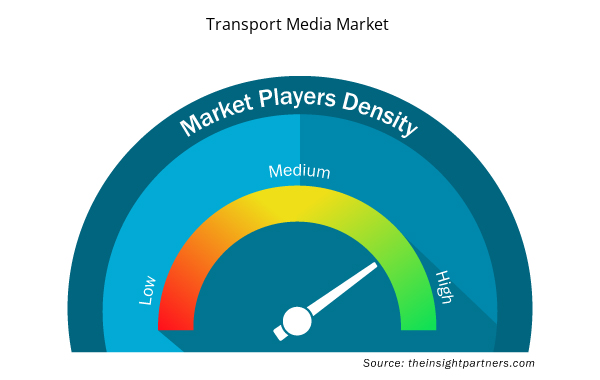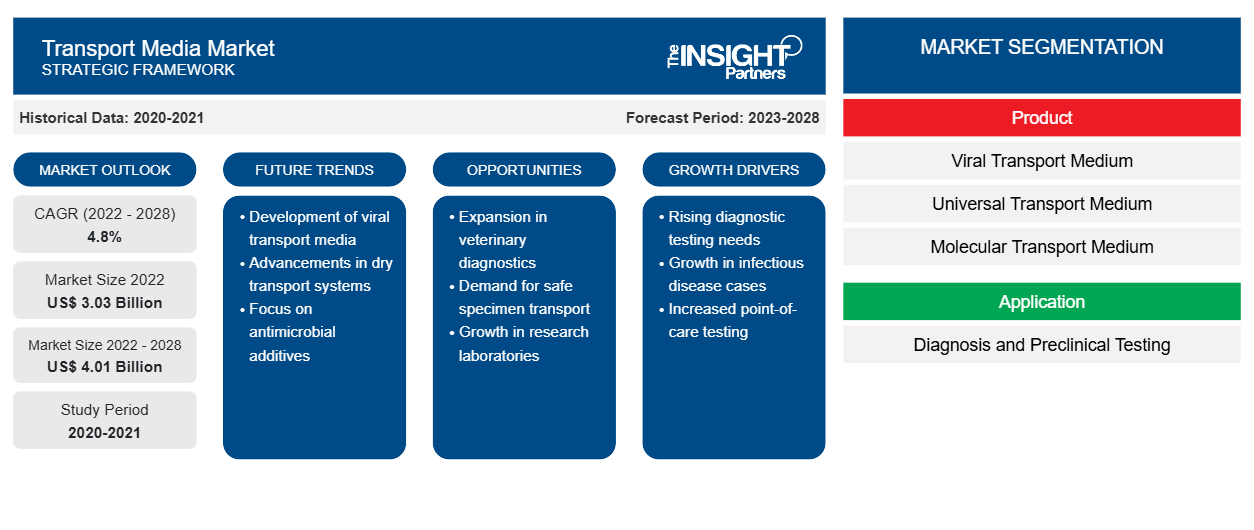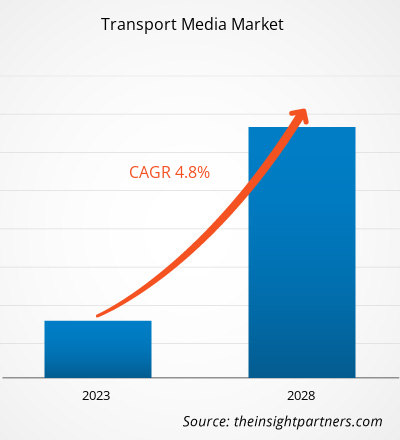Si prevede che il mercato dei media di trasporto crescerà da 3.030,21 milioni di dollari nel 2022 a 4.014,88 milioni di dollari entro il 2028; si prevede che registrerà un CAGR del 4,8% dal 2021 al 2028.CAGR of 4.8% from 2021 to 2028.
Il mezzo di trasporto microbico è essenzialmente un tampone contenente nutrienti (esclusi i fattori di crescita) come carboidrati e peptoni, ed è progettato per mantenere la vitalità batterica durante il trasporto senza crescita batterica. Lo scopo principale dell'utilizzo di un mezzo di trasporto è quello di consegnare il campione il più vicino possibile al suo stato originale.peptones, and is designed to maintain bacterial viability during transport without bacterial growth. The main purpose of using a transport medium is to deliver the sample as close to its original state as possible.
La crescita del mercato dei mezzi di trasporto è attribuita all'aumento della domanda dovuto al crescente numero di iniziative adottate dal governo per aumentare il tasso di adozione dei kit di test. Tuttavia, problemi clinici e tecnici correlati alla raccolta dei tamponi e ai mezzi di trasporto limitano la crescita del mercato.
Il mercato dei media di trasporto è segmentato in base a prodotto, applicazione, utente finale e area geografica. In base all'area geografica, il mercato è ampiamente segmentato in Nord America, Europa, Asia Pacifico, Medio Oriente e Africa e Sud e Centro America. Il rapporto di mercato offre approfondimenti e analisi approfondite del mercato, sottolineando parametri quali dimensioni del mercato, tendenze, progressi tecnologici e dinamiche di mercato, nonché l'analisi del panorama competitivo dei principali attori del mercato a livello mondiale. Inoltre, il rapporto include l'impatto della pandemia di COVID-19 sul mercato dei media di trasporto in tutte le regioni.
Personalizza questo report in base alle tue esigenze
Riceverai la personalizzazione gratuita di qualsiasi report, comprese parti di questo report, o analisi a livello nazionale, pacchetto dati Excel, oltre a usufruire di grandi offerte e sconti per start-up e università
- Scopri le principali tendenze di mercato in questo rapporto.Questo campione GRATUITO includerà analisi di dati che spaziano dalle tendenze di mercato alle stime e alle previsioni.
Approfondimenti di mercato
L'aumento della domanda dovuto alla pandemia di COVID-19 stimola la crescita del mercato dei media sui trasporti
La domanda di terreni di trasporto è aumentata con l'aumento dei test per il COVID-19. Affinché i test siano accurati e affidabili, la qualità del campione e le condizioni di trasporto e conservazione del campione prima dell'elaborazione sono fondamentali. Per questo, l'uso di un terreno di trasporto virale è diventato comune e la sua domanda è aumentata esponenzialmente. I terreni di trasporto virale più comunemente utilizzati erano le provette di plastica con tappo a vite contenenti proteine tamponate e antibiotici per prevenire la crescita di contaminanti, come batteri e funghi. Molte aziende hanno avviato la produzione in serie di un terreno di trasporto virale per il trasporto di campioni di tamponi nasofaringei e orofaringei ai laboratori diagnostici per la conferma. Inoltre, molte università e organizzazioni di ricerca hanno supportato il processo di produzione riducendo i progetti di ricerca per prevenire focolai sul posto di lavoro. Hanno spostato le loro operazioni sulla produzione personalizzata di terreni di trasporto virale per produrre kit di test per il COVID-19. Ad esempio, l'Ohio State University Wexner Medical Center ha collaborato con i suoi laboratori e studenti correlati per produrre 254.791 provette per test di terreni di trasporto virale per una rapida distribuzione in tutto l'Ohio.nasopharyngeal and oropharyngeal swab specimens to diagnostic laboratories for confirmation. Further, many universities and research organizations supported the production process by reducing research projects to prevent workplace outbreaks. They shifted their operations to custom production of viral transport medium to produce COVID-19 test kits. For instance, the Ohio State University Wexner Medical Center collaborated with its related laboratories and students to produced 254,791 viral transport media testing tubes for prompt distribution throughout Ohio.
Con l'aspettativa di ulteriori ondate della pandemia di COVID-19 a livello regionale, sono necessari test COVID-19 robusti e su larga scala per prevenire impatti negativi, come la perdita di vite umane. Si prevede che ciò guiderà il mercato dei media di trasporto, in particolare dei media di trasporto virali, nei prossimi anni. Inoltre, oltre al SARS-CoV-2, stanno diventando comuni vari altri focolai di malattie infettive, che richiedono test rapidi e un lavoro di ricerca che dovrebbe anche aiutare la crescita del mercato.
Tuttavia, la pandemia di COVID-19 ha gravemente interrotto le forniture mondiali di terreni di trasporto virali (VTM) a causa della domanda diffusa di test di trascrizione inversa-PCR (RT-PCR) per la sindrome respiratoria acuta grave coronavirus 2 (SARS-CoV-2). In risposta a questa carenza in corso, gli operatori di mercato che operano nella regione hanno iniziato la produzione interna di VTM a supporto dei test diagnostici nella rete ospedaliera. Ad esempio: nell'ottobre 2020, COPAN Diagnostics Inc. ha annunciato che 5 milioni di UTM (Universal Transport Medium) sono stati spediti dal nuovo stabilimento di produzione dell'azienda a Carlsbad, in California, per svolgere un ruolo fondamentale nella lotta contro il virus mortale.VTM) due to widespread demand for severe acute respiratory syndrome coronavirus 2 (SARS-CoV-2) reverse transcription-PCR (RT-PCR) testing. In response to this ongoing shortage, market players operating in the region began the production of VTM in-house in support of diagnostic testing in the hospital network. For Instance: In October 2020, COPAN Diagnostics Inc. announced that 5 million UTM (Universal Transport Medium) was shipped from the company's new manufacturing facility in Carlsbad, California, to play an integral part in the battle against the deadly virus.
Approfondimenti basati sui prodotti
In base al prodotto, il mercato dei media di trasporto è segmentato in media di trasporto virale, media di trasporto universale, media di trasporto molecolare e altri. Nel 2022, il segmento dei media di trasporto virale deteneva la quota maggiore del mercato. Tuttavia, si prevede che il segmento dei media di trasporto molecolare registrerà il CAGR più elevato del 5,2% durante il periodo di previsione.CAGR of 5.2% during the forecast period.
Approfondimenti basati sulle applicazioni
In base all'applicazione, il mercato dei mezzi di trasporto è diviso in diagnosi e test preclinici. Il segmento della diagnosi ha detenuto la quota di mercato più grande nel 2022. Inoltre, si prevede che lo stesso segmento registrerà il CAGR più elevato durante il periodo di previsione.preclinical testing. The diagnosis segment held the largest market share in 2022. Moreover, the same segment is anticipated to register the highest CAGR during the forecast period.
Informazioni basate sull'utente finale
In base all'utente finale, il mercato dei mezzi di trasporto è segmentato in ospedali e cliniche, laboratori di microbiologia, laboratori di diagnostica e altri. Tuttavia, si prevede che il segmento dei laboratori di diagnostica registrerà il CAGR più elevato durante il periodo di previsione.CAGR during the forecast period.
Gli operatori del mercato dei media di trasporto si concentrano sull'adozione di strategie organiche, come il lancio e l'espansione dei prodotti, per ampliare la propria presenza e il proprio portafoglio prodotti a livello globale e soddisfare la crescente domanda.
Approfondimenti regionali sul mercato dei media di trasporto
Le tendenze regionali e i fattori che influenzano il Transport Media Market durante il periodo di previsione sono stati ampiamente spiegati dagli analisti di Insight Partners. Questa sezione discute anche i segmenti e la geografia del Transport Media Market in Nord America, Europa, Asia Pacifico, Medio Oriente e Africa, e Sud e Centro America.

- Ottieni i dati specifici regionali per il mercato dei media di trasporto
Ambito del rapporto sul mercato dei media di trasporto
| Attributo del report | Dettagli |
|---|---|
| Dimensioni del mercato nel 2022 | 3,03 miliardi di dollari USA |
| Dimensioni del mercato entro il 2028 | 4,01 miliardi di dollari USA |
| CAGR globale (2022 - 2028) | 4,8% |
| Dati storici | 2020-2021 |
| Periodo di previsione | 2023-2028 |
| Segmenti coperti | Per Prodotto
|
| Regioni e Paesi coperti | America del Nord
|
| Leader di mercato e profili aziendali chiave |
|
Densità degli attori del mercato dei media di trasporto: comprendere il suo impatto sulle dinamiche aziendali
Il mercato dei media di trasporto sta crescendo rapidamente, spinto dalla crescente domanda degli utenti finali dovuta a fattori quali l'evoluzione delle preferenze dei consumatori, i progressi tecnologici e una maggiore consapevolezza dei vantaggi del prodotto. Con l'aumento della domanda, le aziende stanno ampliando le loro offerte, innovando per soddisfare le esigenze dei consumatori e capitalizzando sulle tendenze emergenti, il che alimenta ulteriormente la crescita del mercato.
La densità degli operatori di mercato si riferisce alla distribuzione di aziende o società che operano in un particolare mercato o settore. Indica quanti concorrenti (operatori di mercato) sono presenti in un dato spazio di mercato in relazione alle sue dimensioni o al valore di mercato totale.
Le principali aziende che operano nel mercato dei media di trasporto sono:
- THERMO FISHER SCIENTIFIC INC.
- BD
- Diagnostica EKF
- Prodotti medici puritani
- Laboratori HiMedia
Disclaimer : le aziende elencate sopra non sono classificate secondo un ordine particolare.

- Ottieni una panoramica dei principali attori del mercato dei media di trasporto
Per Geografia
In base all'area geografica, il mercato dei media di trasporto è segmentato in Nord America (Stati Uniti, Canada e Messico), Europa (Regno Unito, Germania, Francia, Italia, Spagna e resto d'Europa), Asia Pacifico (Cina, Giappone, India, Australia, Corea del Sud e resto dell'Asia Pacifico), Medio Oriente e Africa (Emirati Arabi Uniti, Arabia Saudita, Sudafrica e resto del Medio Oriente e dell'Africa) e Sud e Centro America (Brasile, Argentina e resto del Sud e Centro America).
Profili aziendali
- Thermo Fisher Scientific Inc.
- BD
- Diagnostica EKF
- Prodotti medici puritani
- Laboratori HiMedia
- Trinità Biotech
- VIRCELLELLA SL
- Cavi e attrezzature mediche
- COPAN Diagnostics Inc.
- Tecnologia
- Analisi storica (2 anni), anno base, previsione (7 anni) con CAGR
- Analisi PEST e SWOT
- Valore/volume delle dimensioni del mercato - Globale, regionale, nazionale
- Industria e panorama competitivo
- Set di dati Excel


- Cosmetic Bioactive Ingredients Market
- Resistance Bands Market
- Passport Reader Market
- Airline Ancillary Services Market
- Portable Power Station Market
- Formwork System Market
- Airport Runway FOD Detection Systems Market
- Ceiling Fans Market
- Data Annotation Tools Market
- Space Situational Awareness (SSA) Market

Report Coverage
Revenue forecast, Company Analysis, Industry landscape, Growth factors, and Trends

Segment Covered
This text is related
to segments covered.

Regional Scope
North America, Europe, Asia Pacific, Middle East & Africa, South & Central America

Country Scope
This text is related
to country scope.
Domande frequenti
Global transport media market is segmented by region into North America, Europe, Asia Pacific, Middle East & Africa and South & Central America. In North America, the U.S. is the largest market for transport media. The US is estimated to hold the largest share in the transport media market during the forecast period. The growing number of diagnostic tests along with prevalence of various market players.
However, increasing number of initiatives adopted by government for the prevalence of testing kits, rise in number of infectious diseases and increasing number of emerging and small size manufacturers in the Asia-Pacific is expected to account for the fastest growth of the region during the coming years
The transport media market majorly consists of the players such as Thermo Fisher Scientific, Inc.; BD: EKF Diagnostics; Puritan Medical Products; HiMedia Laboratories; Trinity Biotech; VIRCELL S.L; Medical Wire & Equipment; COPAN Diagnostics Inc.; Teknova; amongst others.
The hospitals and clinics segment dominated the global transport media market and held the largest revenue share of 61.82% in 2022.
The COVID-19 segment dominated the global transport media market and held the largest revenue share of 68.86% in 2022.
The viral transport media segment dominated the global transport media market and held the largest revenue share of 56.36% in 2022.
The diagnosis segment dominated the global transport media market and held the largest revenue share of 85.05% in 2022.
Transport media are buffer solutions containing carbohydrates, peptones, and other nutrients, apart from growth factors, designed for the transport of microorganisms while preserving the viability of the microbe. Transport media are designed to arrest any growth of the microbial sample. A transport media is of three major types, viral transport media, universal transport media, and molecular transport media, with VTM being the most prominently used media at present.
Key factors that are driving the growth of this market are increase in research studies, and rise in demand due to the COVID-19 pandemic.
Trends and growth analysis reports related to Life Sciences : READ MORE..
The List Of Companies - Transport Media Market
- THERMO FISHER SCIENTIFIC INC.
- BD
- EKF Diagnostics
- Puritan Medical Products
- HiMedia Laboratories
- Trinity Biotech
- VIRCELL S.L
- Medical Wire & Equipment
- COPAN Diagnostics Inc.
- Teknova
The Insight Partners performs research in 4 major stages: Data Collection & Secondary Research, Primary Research, Data Analysis and Data Triangulation & Final Review.
- Data Collection and Secondary Research:
As a market research and consulting firm operating from a decade, we have published and advised several client across the globe. First step for any study will start with an assessment of currently available data and insights from existing reports. Further, historical and current market information is collected from Investor Presentations, Annual Reports, SEC Filings, etc., and other information related to company’s performance and market positioning are gathered from Paid Databases (Factiva, Hoovers, and Reuters) and various other publications available in public domain.
Several associations trade associates, technical forums, institutes, societies and organization are accessed to gain technical as well as market related insights through their publications such as research papers, blogs and press releases related to the studies are referred to get cues about the market. Further, white papers, journals, magazines, and other news articles published in last 3 years are scrutinized and analyzed to understand the current market trends.
- Primary Research:
The primarily interview analysis comprise of data obtained from industry participants interview and answers to survey questions gathered by in-house primary team.
For primary research, interviews are conducted with industry experts/CEOs/Marketing Managers/VPs/Subject Matter Experts from both demand and supply side to get a 360-degree view of the market. The primary team conducts several interviews based on the complexity of the markets to understand the various market trends and dynamics which makes research more credible and precise.
A typical research interview fulfils the following functions:
- Provides first-hand information on the market size, market trends, growth trends, competitive landscape, and outlook
- Validates and strengthens in-house secondary research findings
- Develops the analysis team’s expertise and market understanding
Primary research involves email interactions and telephone interviews for each market, category, segment, and sub-segment across geographies. The participants who typically take part in such a process include, but are not limited to:
- Industry participants: VPs, business development managers, market intelligence managers and national sales managers
- Outside experts: Valuation experts, research analysts and key opinion leaders specializing in the electronics and semiconductor industry.
Below is the breakup of our primary respondents by company, designation, and region:

Once we receive the confirmation from primary research sources or primary respondents, we finalize the base year market estimation and forecast the data as per the macroeconomic and microeconomic factors assessed during data collection.
- Data Analysis:
Once data is validated through both secondary as well as primary respondents, we finalize the market estimations by hypothesis formulation and factor analysis at regional and country level.
- Macro-Economic Factor Analysis:
We analyse macroeconomic indicators such the gross domestic product (GDP), increase in the demand for goods and services across industries, technological advancement, regional economic growth, governmental policies, the influence of COVID-19, PEST analysis, and other aspects. This analysis aids in setting benchmarks for various nations/regions and approximating market splits. Additionally, the general trend of the aforementioned components aid in determining the market's development possibilities.
- Country Level Data:
Various factors that are especially aligned to the country are taken into account to determine the market size for a certain area and country, including the presence of vendors, such as headquarters and offices, the country's GDP, demand patterns, and industry growth. To comprehend the market dynamics for the nation, a number of growth variables, inhibitors, application areas, and current market trends are researched. The aforementioned elements aid in determining the country's overall market's growth potential.
- Company Profile:
The “Table of Contents” is formulated by listing and analyzing more than 25 - 30 companies operating in the market ecosystem across geographies. However, we profile only 10 companies as a standard practice in our syndicate reports. These 10 companies comprise leading, emerging, and regional players. Nonetheless, our analysis is not restricted to the 10 listed companies, we also analyze other companies present in the market to develop a holistic view and understand the prevailing trends. The “Company Profiles” section in the report covers key facts, business description, products & services, financial information, SWOT analysis, and key developments. The financial information presented is extracted from the annual reports and official documents of the publicly listed companies. Upon collecting the information for the sections of respective companies, we verify them via various primary sources and then compile the data in respective company profiles. The company level information helps us in deriving the base number as well as in forecasting the market size.
- Developing Base Number:
Aggregation of sales statistics (2020-2022) and macro-economic factor, and other secondary and primary research insights are utilized to arrive at base number and related market shares for 2022. The data gaps are identified in this step and relevant market data is analyzed, collected from paid primary interviews or databases. On finalizing the base year market size, forecasts are developed on the basis of macro-economic, industry and market growth factors and company level analysis.
- Data Triangulation and Final Review:
The market findings and base year market size calculations are validated from supply as well as demand side. Demand side validations are based on macro-economic factor analysis and benchmarks for respective regions and countries. In case of supply side validations, revenues of major companies are estimated (in case not available) based on industry benchmark, approximate number of employees, product portfolio, and primary interviews revenues are gathered. Further revenue from target product/service segment is assessed to avoid overshooting of market statistics. In case of heavy deviations between supply and demand side values, all thes steps are repeated to achieve synchronization.
We follow an iterative model, wherein we share our research findings with Subject Matter Experts (SME’s) and Key Opinion Leaders (KOLs) until consensus view of the market is not formulated – this model negates any drastic deviation in the opinions of experts. Only validated and universally acceptable research findings are quoted in our reports.
We have important check points that we use to validate our research findings – which we call – data triangulation, where we validate the information, we generate from secondary sources with primary interviews and then we re-validate with our internal data bases and Subject matter experts. This comprehensive model enables us to deliver high quality, reliable data in shortest possible time.


 Ottieni un campione gratuito per questo repot
Ottieni un campione gratuito per questo repot